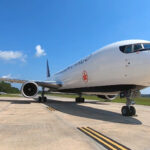Thai Airways has disclosed the dissolution of its subsidiary Thai Smile Airways, with plans to operate both fleets under the parent company’s name. This resolution was approved by the Creditors Committee, in alignment with the roadmap proposed by the Plan Administrators and company executives.
Taking a new stride in its restructuring journey, Thailand’s national airline seeks to escape the profound crisis it finds itself in. The Creditors Committee has greenlit the fusion of Thai Airways and Thai Smile to mitigate operational costs of running two airlines with separate Air Operator Certificates (AOC). The restructuring process, requiring approval from respective authorities including the Minister of Transport and the Civil Aviation Authority of Thailand, is expected to be completed by 2023.
Challenges and Competitive Dynamics
The committee highlighted that maintaining two airlines with distinct AOCs obstructs the company’s recovery. Separate operations, flight planning, scheduling, and route networks limit the efficient fleet management necessary to swiftly adapt to market competition.
Another determining factor is the escalating price competition on short-haul routes. Low-cost airlines offering prices lower than Thai Smile can currently achieve severely undermine the company’s competitiveness.
Next Steps Post-Merger
Once restructuring concludes, all operations, flight planning, and route networks will fall under Thai Airways’ purview, operating solely under its AOC. This move is expected to result in greater flexibility in business operations.
This restructuring will strengthen the company’s aviation business operations in several aspects:
- Operating under a single AOC will enhance the ability to design flight networks and routes that better meet customer needs and connective flight convenience (Hub & Spoke). With the ability to switch aircraft depending on flight distance and market demands, efficient management of both narrow and wide-bodied aircraft will be possible.
- Unifying the brand identity of Thai Airways and Thai Smile Airways will eradicate marketing ambiguities, as services and operations are under one management.
Reducing Operations and Human Resources
Reducing redundancy in operations, including human resources like pilots and flight attendants, will lead to integration of support systems, flight operations, and various resources. This will enable the company to more efficiently manage revenue and costs.
The restructuring won’t significantly impact services provided to Thai Smile Airways’ passengers, as all personnel, including executives, employees, pilots, and flight attendants, will join the parent company.
Moreover, the company has analyzed various aspects including finance, business continuity, and legal considerations. It concluded that restructuring will assist the companies in achieving their rehabilitation and business reform plans’ objectives.














